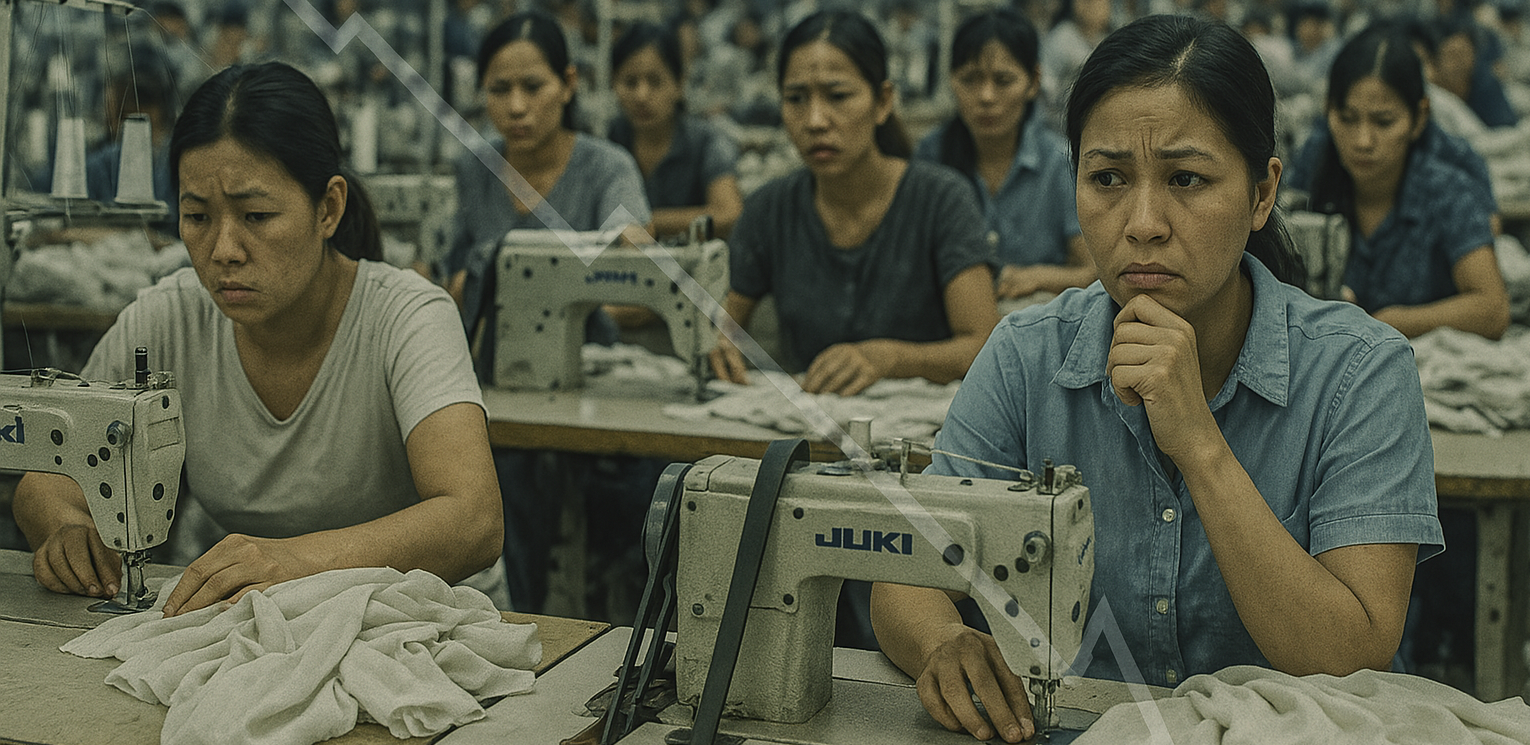U.S.-Vietnam Tariff Dispute: An In-Depth Report as of April 9, 2025
The U.S.-Vietnam tariff dispute, escalating with a 46% tariff imposed by the United States effective today, April 9, 2025, is more than a trade spat—it’s a seismic shift with global reverberations. This comprehensive report unpacks the history, economic fallout, and geopolitical stakes, offering a deep dive into a saga affecting millions of livelihoods, from factory floors in Hanoi to checkout lines in Houston.
Introduction: Why U.S.-Vietnam Trade Hits Home
Imagine snagging a pair of Nike sneakers for $100 last week, only to see them priced at $150 today—or picking up a Samsung phone that’s suddenly $200 pricier. That’s the stark reality as the U.S. unleashes a 46% tariff on Vietnamese goods, effective April 9, 2025.
Vietnam, a manufacturing powerhouse, shipped $136.6 billion in goods to the U.S. in 2024—a 20% surge from 2023—fueling 30% of its GDP with exports like textiles, electronics, and footwear. For American consumers, it’s a wallet squeeze. For businesses, it’s a supply chain crisis. For the global economy, it’s a test of how far protectionism can stretch before it snaps. This isn’t just numbers—it’s a story of jobs, prices, and power.
Background of Tariffs: A Policy Rooted in Reciprocity
The roots of this tariff clash stretch back to the Trump administration’s “America First” doctrine, reborn in 2025 with renewed vigor. Leveraging the International Emergency Economic Powers Act of 1977, Trump declared trade imbalances a national emergency, targeting countries like Vietnam with aggressive tariffs.
The U.S. claims Vietnam imposes a 90% tariff on American goods—a figure Hanoi disputes, citing an average applied rate of 9.4% in 2023—prompting the 46% reciprocal tariff now in play.
This isn’t a sudden move. Tensions brewed over Vietnam’s $123.5 billion trade surplus with the U.S. in 2024, a figure dwarfing the $104 billion deficit of 2023. The Trump team points to currency manipulation—Vietnam’s dong allegedly undervalued to boost exports—and unfair trade practices, like lax intellectual property enforcement, as justification. The broader goal? Reshore jobs and shrink deficits. But critics argue it’s a blunt tool, risking higher costs and global trade chaos. Vietnam’s rise as a manufacturing hub, filling China’s shoes, only sharpened Washington’s focus.
Chart: U.S. vs. Vietnam Tariff Claims
| Claim Source | Tariff on U.S. Goods | U.S. Response | Trade Deficit (2024) |
|---|---|---|---|
| U.S. Assertion | 90% | 46% tariff on Vietnam | $123.5B |
| Vietnam’s Counter | 9.4% average | Disputes U.S. figure | – |
Vietnam’s Response: Diplomacy, Deals, and Diversification
Vietnam’s leaders saw the tariff storm coming and sprang into action. On April 5, 2025, Communist Party chief To Lam sent an urgent letter to Trump, requesting a 45-day delay to negotiate—a plea signaling Hanoi’s desperation to protect its export-driven economy. Deputy Prime Minister Bui Thanh Son followed up, meeting U.S. Ambassador Marc Knapper in Hanoi on April 6 to press the case, emphasizing Vietnam’s willingness to compromise.
The diplomatic blitz peaked with Deputy PM Ho Duc Phoc’s appointment as special envoy. He’s in the U.S. from April 6-16, armed with a game-changer: Vietnam’s offer to slash all tariffs on U.S. goods to zero. This could open Vietnam’s 100-million-strong market to American exporters—think Boeing planes or Iowa pork—while softening the blow to its $136.6 billion U.S. export stream.
But Hanoi’s not putting all its eggs in one basket. It’s deepening ties with China, approving projects like a $2 billion rare earths deal with Beijing in March 2025, and boosting trade with the EU and Japan to offset U.S. losses.
Vietnam’s Tariff Fightback Timeline
- March 2025: $2B rare earths deal with China signed
- April 5: To Lam’s letter begs for 45-day delay
- April 6: Bui Thanh Son meets U.S. Ambassador
- April 6-16: Ho Duc Phoc’s U.S. mission underway
- Offer: Zero tariffs on U.S. goods proposed
Impact on U.S. Imports: From Factory to Checkout
Vietnam’s $136.6 billion in U.S. exports in 2024 reads like a consumer catalog: textiles ($44 billion), electronics ($35 billion), footwear ($25 billion), furniture ($15 billion), and seafood ($10 billion). The 46% tariff, effective today, slams these sectors, hiking costs for giants like Nike, Samsung, and Wayfair, who’ve leaned on Vietnam as a China alternative since the U.S.-China trade war flared in 2018.
Take textiles: Vietnam’s garment industry, the world’s second-largest exporter after China, churns out jeans and tees for American Eagle and Gap. That $20 shirt could jump to $30—or more if retailers fully pass on the tariff. Electronics, including phone components, face similar hikes, threatening price tags on gadgets Americans snap up daily. Seafood lovers aren’t spared—shrimp and catfish prices could climb, hitting restaurants and grocery bills.
Volume-wise, Vietnam’s exports grew 20% last year alone, making this tariff a body blow to a critical supply chain.
Top U.S. Imports from Vietnam (2024)
| Category | Value ($B) | Key Players | Tariff Impact Example |
|---|---|---|---|
| Textiles | 44 | American Eagle, Gap | $20 shirt → $30 |
| Electronics | 35 | Samsung, Intel | Phone parts cost up 46% |
| Footwear | 25 | Nike, Adidas | $100 sneakers → $150 |
| Furniture | 15 | Wayfair, IKEA | $200 table → $300 |
| Seafood | 10 | Red Lobster | Shrimp dinner price hike |
Cost to U.S. Businesses and Taxpayers: A Protectionist Price Tag
The tariff’s shockwaves ripple across U.S. commerce. Big retailers like Nike, with 40% of its footwear sourced from Vietnam, face a cost explosion—potentially $1 billion extra annually if production stays put. Wayfair, reliant on Vietnamese furniture, might see margins shrink unless it hikes prices or finds new suppliers—a slow, costly shift. Analysts estimate U.S. importers could shoulder $60 billion in added costs from this tariff alone, much of it trickling down to shoppers.
Small businesses, less equipped to absorb the hit, are in deeper trouble. A mom-and-pop retailer importing $50,000 in Vietnamese chairs yearly now faces a $23,000 tariff bill—enough to wipe out profits or force layoffs. For taxpayers, the stakes are indirect but real: higher goods costs could fuel inflation, already a hot topic in 2025 with rates hovering at 3.5%. The Consumer Price Index might tick up 0.5 points, per Oxford Economics, squeezing budgets further. Protectionism’s promise of U.S. jobs comes with a steep consumer tax.
U.S. Cost Breakdown
- Big Retail: Nike: $1B extra cost; Wayfair: Margins slashed
- Small Biz: $50K import → $23K tariff; layoffs loom
- Consumers: $20 shirt → $30; $1,000 phone → $1,200
- Taxpayers: Inflation up 0.5%; 3.5% baseline strained
Economic Impact on Vietnam: A Nation on the Brink
Vietnam’s economy, tethered to U.S. exports for 30% of its $435 billion GDP, faces a reckoning. ING forecasts a 5.5% GDP drop—slashing growth from an 8% target to 2.5%-5%—while the World Bank warns of a $40 billion export loss if the tariff sticks. The stock market’s 7% plunge on tariff news, the worst in two decades, reflects investor dread.
The human toll is staggering. Vietnam’s 2.5 million textile and footwear workers, mostly rural women earning $200 a month, are at risk—200,000 jobs could vanish by December if U.S. orders dry up, per the Vietnam Textile and Apparel Association. Electronics plants, employing another million, face similar cuts.
Hanoi’s response? A $10 billion stimulus plan, announced April 7, targets domestic manufacturing and new markets like India and ASEAN. But replacing the U.S., its top buyer, could take years.
Vietnam’s Economic Hit
| Metric | Pre-Tariff (2024) | Post-Tariff (Est. 2025) | Notes |
|---|---|---|---|
| GDP Growth | 7% | 2.5%-5% | ING forecast |
| Export Value | $136.6B | $96.6B | $40B loss projected |
| Jobs at Risk | – | 200,000 | Textiles, electronics |
| Stock Index | Stable | -7% | Post-tariff crash |
Geopolitical Context: A Tightrope Between Titans
This tariff isn’t just dollars and cents—it’s a geopolitical pivot point. Vietnam’s manufacturing boom piggybacked on the U.S.-China trade war, with firms like Intel and Adidas flocking there since 2019. The 46% tariff threatens that edge, potentially driving Vietnam into China’s orbit—just as the U.S. needs it as a Southeast Asian counterweight.
Biden’s 2023 “comprehensive strategic partnership” with Hanoi aimed to deepen ties, but this tariff could unravel it. Vietnam’s already hedging: a $2 billion rare earths deal with China in March 2025, plus talks for a Hanoi-Beijing rail link, signal a shift.
Yet Hanoi’s also courting Trump, offering tariff cuts and approving Starlink’s entry in February 2025 to woo U.S. tech. It’s a high-stakes balancing act—lean too far either way, and Vietnam risks losing leverage in a region where U.S.-China rivalry burns hot.
Expert Opinions: A Chorus of Concern
The tariff’s drawn sharp takes from the sharpest minds. The American Chamber of Commerce in Vietnam, representing 1,200 firms, labels it “disruptive,” urging a delay to protect $10 billion in annual U.S. investments there. ING’s Peter Mumford predicts a 5.5% GDP hit, while trade analyst Deborah Elms warns reshoring to the U.S. could take a decade—too late to offset losses.
Long-term views split. Economist Nguyen Anh Tuan sees Vietnam pivoting to China, noting a 15% trade uptick with Beijing in Q1 2025. Conversely, ex-USTR official Wendy Cutler bets a post-2028 administration might scrap the tariffs if consumer backlash grows.
“It’s illogical to kneecap an ally,” a Washington Post op-ed argued, echoing a view that this could backfire on U.S. influence. The debate’s fierce—and unresolved.
Expert Takes
- AmCham: “Disruptive—delay it”; $10B investment at risk
- ING: “5.5% GDP drop imminent”
- Elms: “Reshoring’s a pipe dream”
- Tuan: “China trade up 15% already”
- Cutler: “Post-2028 rollback possible”
Conclusion: A Trade Tale With No End in Sight
The 46% tariff on Vietnam, live as of April 9, 2025, is a bold stroke with messy fallout. For the U.S., it’s pricier goods and a gamble on jobs. For Vietnam, it’s an economic cliff and a diplomatic dance. Hanoi’s zero-tariff offer could spark a deal, but Trump’s track record leans hardline—talks this month will tell.
This clash lays bare a truth: protectionism’s a double-edged sword, slicing through wallets and alliances alike. As supply chains strain and prices climb, the question looms larger: Can the U.S. and Vietnam find common ground, or will this tariff redraw the map of global trade for a generation?


























